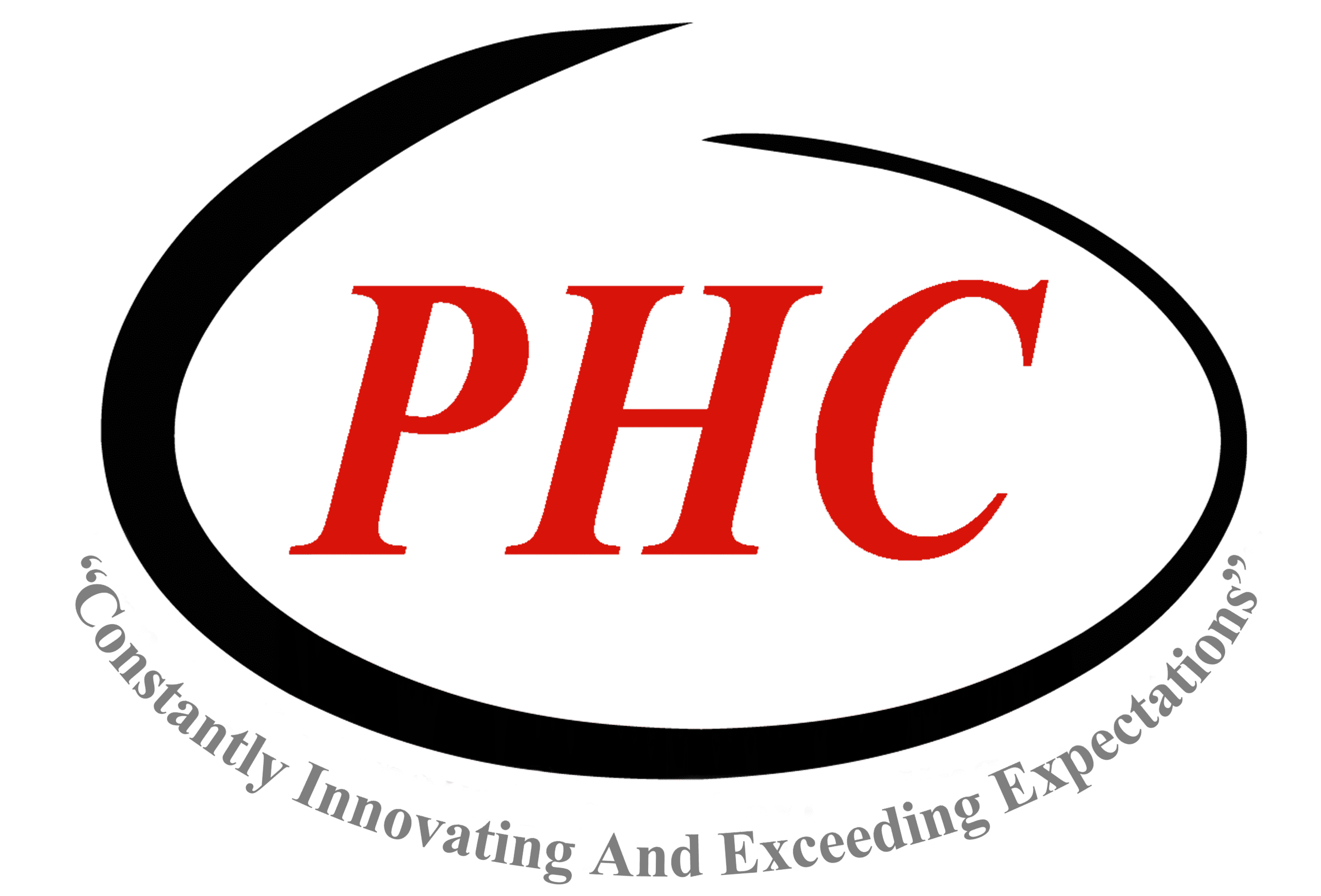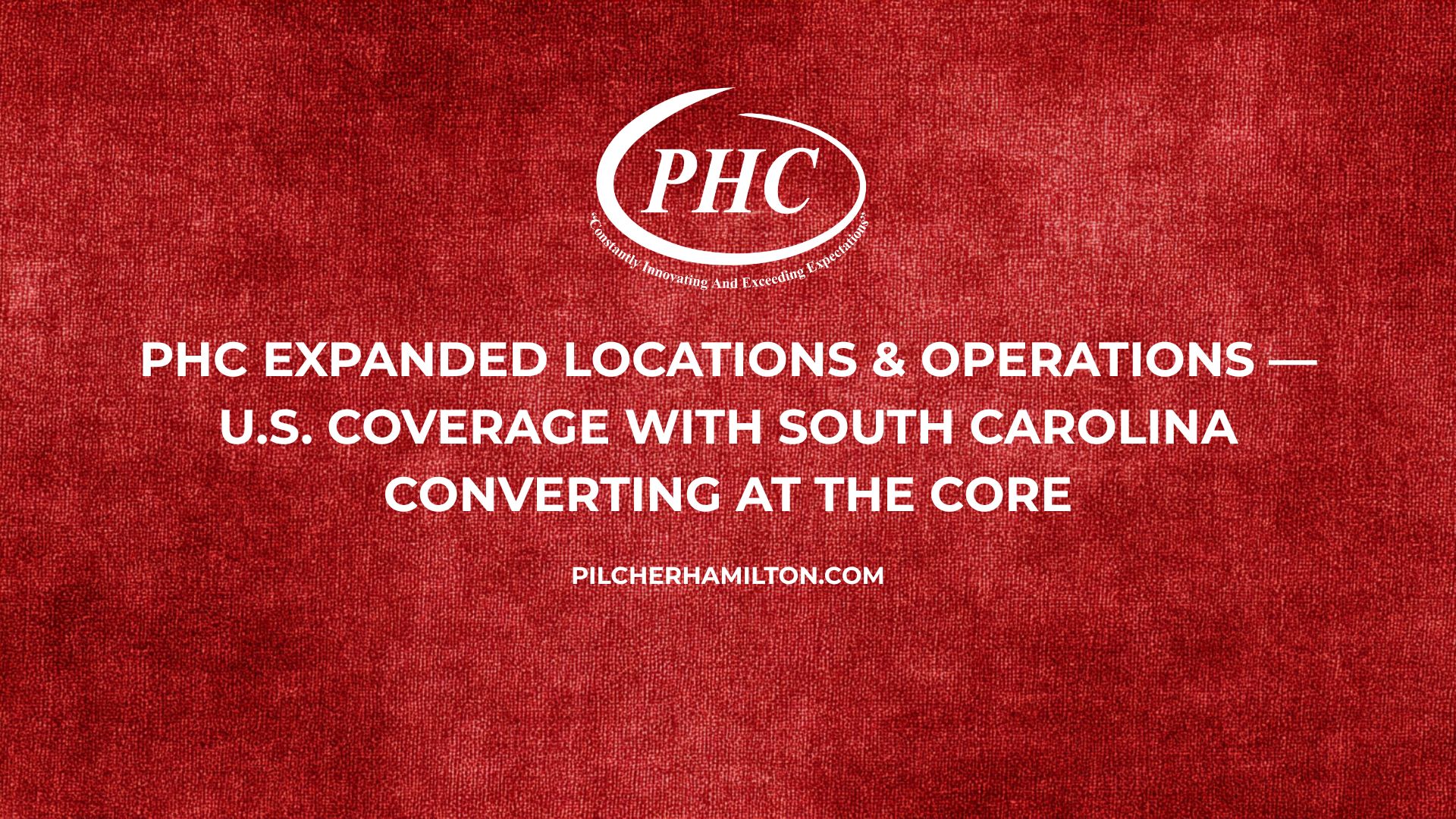Polyester Film Converting. Engineer’s summary: Pilcher Hamilton Corporation (PHC) is a merchant supplier and converter of polyester films (PET/BOPET)—not a primary film manufacturer. We stock >10,000,000 lb across common gauges and constructions for 24–48‑hour shipment and add value through slitting, coating (PVDC, silicone, acrylic, anti‑fog, anti‑static), corona treatment, sheeting, winding, printing, and toll converting. Our converting/manufacturing hub in Greer, South Carolina sits beside the country’s largest polyester production cluster (e.g., Mitsubishi Polyester Film in Greer, SC), which shortens supply lanes, stabilizes quality, and enables fast trials and scale‑ups. Typical specification windows we support: 8–200 µm thickness, 38–52 dyn/cm surface energy, 0.2–0.6 COF, 200–400 °F seal windows, and barrier down to OTR <1 cc/m²/day; WVTR <1 g/m²/day depending on structure. We also run PCR PET programs up to 90% recycled content.
Explore PHC’s capabilities and ranges: All Products • All Services • Supplier overview.
U.S. Footprint & Contact Directory
Home Office (Administration & Operations Oversight)
- 6845 Kingery Highway, Willowbrook, IL 60527
- 630‑655‑8100 ext. 107 • info@pilcherhamilton.com
- Function: customer operations, finance, planning, QA systems governance, national account coordination.
Manufacturing / Converting Facility (SC Hub)
- 850 South Buncombe Road, Greer, SC 29650
- 864‑877‑7900 ext. 200 • info@pilcherhamilton.com
- Function: core converting & production—slitting, sheeting, roll‑to‑roll coating (PVDC, silicone, acrylic, anti‑fog/anti‑static), in‑line corona treatment and rewinding. This is the primary distribution node for 24–48‑hour shipments from stock.
- Learn more: Slitting • Sheeting • Coating • Corona treated • Winding.
Distribution & Services Facility (SC)
- 850 Buncombe Road, Greer, SC 29651
- 864‑877‑7900 ext. 201 • Tim.harmon@pilcherhamilton.com
- Function: warehousing, fulfillment, and value‑added kitting supporting same‑day pick/pack, QA holds/releases, and outbound LTL/FTL.
Sales Coverage (Southeast & Northeast)
- Marietta, GA — 770‑509‑0422 • joe.stehlik@pilcherhamilton.com
- Winston‑Salem, NC — 630‑655‑8100 ext. 103 • joanne.staszak@pilcherhamilton.com
- Phillipsburg, NJ — 908‑213‑3754 • rich.badway@pilcherhamilton.com
Locations summary & map: PHC Locations • Contact us.
How PHC Operates Across States (and Why SC is the Engine)
We source domestically and convert centrally. PHC buys base PET/BOPET from leading U.S. producers—with South Carolina and Alabama as anchor supply corridors—and finishes to spec in Greer, SC. South Carolina is a polyester epicenter; Greer’s proximity to Mitsubishi Polyester Film’s major BOPET plant improves base‑web availability, QA collaboration, and changeover responsiveness. Alabama (Decatur) provides another U.S. production corridor that complements our SC hub.
Accuracy note on Ohio: some users list Ohio among PET film states; Ohio’s well‑known Circleville complex is a polyimide (Kapton®) site, not PET/BOPET. PET manufacturing hubs in the U.S. are better represented by SC (Greer) and additional capacity in AL, RI, GA, KY, VA. PHC can still convert polyimide and specialty films on a toll basis when required, quoting separately due to material handling and cost considerations.
Multi‑state sales + single‑hub converting = speed + control. By consolidating converting, coating, and QA in Greer while providing local sales engagement in GA/NC/NJ, PHC gives you one SOP for films across applications and regions—no matter where your plant runs. For “polyester near me” searches, Greer, South Carolina is a strategic logistics point for the Southeast, Mid‑Atlantic, and Northeast.
Technical Windows We Hit Reliably (Engineer‑Ready)
- Gauge (thickness): 8–200 µm (≈0.32–7.87 mil). Stock points include 12, 23, 36, 48, 50, 75, 100, 125, 190 µm.
- Surface energy (dyne): 38–52 dyn/cm via corona or chemical treatment; single‑ or dual‑sided. See Corona‑treated PET and Chemical‑treated.
- Coefficient of friction (COF): 0.2–0.6 film/film (specify static/kinetic and test counterpart). Silicone‑release faces: 0.2–0.4 typical. See Silicone release films.
- Barrier options:
- Metallized PET (Al 20–40 nm): OTR <1 cc/m²/day, WVTR <1 g/m²/day at standard conditions. Metallized films, Barrier PET.
- PVDC‑coated PET: typical OTR 5–10 cc/m²/day and improved moisture barrier with transparency. PVDC‑coated.
- Metallized PET (Al 20–40 nm): OTR <1 cc/m²/day, WVTR <1 g/m²/day at standard conditions. Metallized films, Barrier PET.
- Seal windows: 200–400 °F (93–204 °C) overall; 250–350 °F typical for APET/CPET/PP peelable lidding; weld seals available. Heat‑sealable PET.
- Electrical insulation: Dielectric >3 kV/mil; UL‑recognized grades for motors/coils/slot liners. Electrical PET UL.
- Optics: Graphic‑grade clarity haze <1%; printable topcoats for solvent/UV/waterborne inks. High‑clarity graphic grades.
- Sustainability: PCR PET up to 90% content; printable & metallizable; dyne 38–44 common. PCR films, Sustainability solutions.
Test methods: We align with ASTM D3985 (OTR) and ASTM F1249 (WVTR) at stated temperature/humidity; seal curves captured against your jaws/dwell/pressure; COF against film/film or film/steel per your standard.
Product Families (with Regional/Sustainability Notes)
- Metallized Polyester Films — vacuum‑deposited Al 20–40 nm on PET
- Gauges: 8–23 µm; OTR <1; WVTR <1 typical at 23 °C; high gloss and light/oxygen barrier for coffee, snacks, dry dairy.
- Supply/operations: Stocked and slit in Greer, SC; metallized base webs sourced from U.S. producers; PCR‑capable bases on request.
- Learn more: Metallized, Barrier PET.
- Gauges: 8–23 µm; OTR <1; WVTR <1 typical at 23 °C; high gloss and light/oxygen barrier for coffee, snacks, dry dairy.
- PVDC‑Coated Polyester Films — clear oxygen/moisture barrier
- OTR: 5–10 cc/m²/day (typical); transparent for lidding/medical.
- Coating at PHC: 1–3 µm add‑on common in our Greer roll‑to‑roll lines; confirm dyne ≥42 for ink anchorage.
- Learn more: PVDC‑coated.
- OTR: 5–10 cc/m²/day (typical); transparent for lidding/medical.
- Heat‑Sealable Polyester Films — peelable/weldable systems
- Seal window: 250–350 °F typical; seal to APET/CPET/PP with tailored peel forces.
- Applications: tray lidding, flow‑wrap fin/back seals where PET stiffness/clarity is needed.
- Learn more: Heat‑sealable.
- Seal window: 250–350 °F typical; seal to APET/CPET/PP with tailored peel forces.
- Silicone‑Coated Release Films — controlled release liners
- COF: 0.2–0.4; release force windows (low/medium/high); differential systems available.
- Circularity: SC’s ecosystem supports spent liner recovery; ask about regional programs.
- Learn more: Silicone release and Release liners for PSAs.
- COF: 0.2–0.4; release force windows (low/medium/high); differential systems available.
- Acrylic‑ & Chemical‑Treated PET — print/lamination ready
- Dyne: ≥42 dyn/cm; optimized for solvent/UV/waterborne inks/adhesives; haze <1% options for graphics/overlays.
- Learn more: Acrylic coated, Print & laminate PET.
- Dyne: ≥42 dyn/cm; optimized for solvent/UV/waterborne inks/adhesives; haze <1% options for graphics/overlays.
- General‑Purpose Industrial & Electrical PET
- Gauges: 40–200 µm; dielectric >3 kV/mil; UL variants for motors/coils; camber‑managed slitting ±0.005″.
- Learn more: General purpose PET, Electrical PET converting.
- Gauges: 40–200 µm; dielectric >3 kV/mil; UL variants for motors/coils; camber‑managed slitting ±0.005″.
- PCR PET (up to 90% recycled content)
- Dyne: 38–44; printable/metallizable; ideal for sustainable laminations and label/web structures.
- Learn more: PCR films and Sustainability.
- Dyne: 38–44; printable/metallizable; ideal for sustainable laminations and label/web structures.
- BON (biaxially oriented nylon) complements
- Puncture: >100 N typical; used with PET for MAP and retort‑adjacent laminates when toughness is critical.
- Learn more: BON standards.
- Puncture: >100 N typical; used with PET for MAP and retort‑adjacent laminates when toughness is critical.
Converting Services & Tolerances (Greer, SC)
- Slitting: Razor/score; 1–60″ widths; ±0.005″ tolerance; 3″/6″ cores; defect and splice rules agreed upfront. Slitting.
- Sheeting: Guillotine/cross‑cut to 60″ × 100″; ±0.010″ tolerance. Sheeting.
- Roll‑to‑roll coating: 0.5–5 µm dry add‑on typical; PVDC, silicone, acrylic, anti‑fog, anti‑static. Coating.
- Corona treating: Side‑specific; target 38–52 dyn/cm; on‑line dyne verification. Corona treated.
- Winding/rewind: Tension‑controlled; camber‑managed; lot/roll traceability. Winding.
- Printing (flexo): Up to 8 colors (CMYK + specials) where applicable for branding/functional marks.
- Toll converting: Customer‑supplied rolls processed to PHC SOPs; minimum runs ≈ 1,000 lb. Toll converting.
Regional Operating Model & Example Lanes
Southeast Corridor (SC‑GA‑AL):
- Greer, SC converts and ships within 24–48 h on stocked specs.
- Base PET from SC and AL corridors allows:
- Fast A/B trials for metallized vs PVDC barriers (e.g., mPET12 OTR <1 vs PVDC‑PET12 OTR 5–10).
- Line‑ready COF tuning (0.3–0.5 for HFFS/VFFS) and dyne ≥42 for aggressive print/adhesives.
- Fast A/B trials for metallized vs PVDC barriers (e.g., mPET12 OTR <1 vs PVDC‑PET12 OTR 5–10).
- Applications: snacks/coffee films, APET/CPET lidding (seal 250–330 °F), PSA release liners (COF 0.2–0.4), and UL electrical.
Mid‑Atlantic & Northeast (NC‑VA‑NJ‑PA‑RI‑NY):
- Sales in NC and NJ coordinate with Greer converting; RI supply corridor supports graphics/electronics films (high‑clarity, coated).
- Structures: Acrylic‑treated PET (dyne ≥42) for prime labels and overlam, opaque/translucent whites for light‑blocking (opacity 85–95%), and PCR films (30–90% PCR) to support brand ESG goals.
Midwest (IL base office; national coverage):
- Centralized account management in Willowbrook, IL synchronizes multi‑plant releases, QA documentation, and VMI.
- For plants running Kapton® or other specialty films, PHC will toll convert with adapted handling and QA checks.
Sustainability in Operations (Not Just in Resin Choice)
- Regional sourcing (SC, AL, RI) reduces miles and variability; Greer consolidates converting to minimize touches.
- Closed‑loop opportunities for PET release liners and production trims—PHC helps evaluate collection, qualification, and redeployment into first‑quality release films where programs exist.
- PCR up to 90% for packaging/graphics webs; we maintain dyne 38–44 and validate print & lamination behavior.
- Right‑sized structures: Our roll‑to‑roll coatings (e.g., PVDC 1–3 µm) can deliver barrier targets without over‑laminating, improving mass balance and end‑of‑life prospects.
- Learn more: Sustainability First (USA) • PCR PET.
RFQ Checklist (so we hit your spec on Lot 1)
Application & structure
- Example: mPET12 // PE70 (target OTR <1; WVTR <1), or PVDC‑PET12 // PE60 (target OTR 5–10).
Gauge & tolerances
- 8–200 µm (note caliper method and ± tolerance).
Surface / adhesion
- Dyne: target 38–52 dyn/cm; corona or chemical; which side(s).
- Primer/coats (acrylic, silicone, anti‑fog, anti‑static); which face is treated vs print/release/seal.
Slip / COF
- Static/kinetic targets: 0.2–0.6 (film/film; or specify film/steel).
- Release force window (low/med/high) if silicone.
Seal behavior
- Partner (APET/CPET/PP/PE); seal window (200–400 °F, typical 250–350 °F); peel vs weld; peel force (N/15 mm); jaw dwell/pressure.
Optics & electrical (if relevant)
- Haze %, gloss GU; white opacity 85–95%; dielectric >3 kV/mil; UL grade.
Roll build & logistics
- Width(s) and tolerance ±0.005″, OD/roll length, core 3″/6″, splice policy, defect mapping, packaging method, labeling.
Sustainability / EoL
- PCR % target, interest in liner/trims recovery, APR design constraints (e.g., mono‑PE path vs performance‑led PET laminates).
Example Structures by Use Case (Ready to Trial)
- High‑barrier snacks/coffee: mPET12 (OTR <1; WVTR <1) // PE70; dyne ≥42 on print face; COF 0.3–0.5.
- Transparent barrier lidding: PVDC‑PET12 (OTR 5–10) // PE60; peelable seal 250–330 °F to APET/CPET; dyne ≥42 for inks.
- PSA/graphics liners: Si‑PET23–75; COF 0.2–0.4; differential release options; consider SC‑based liner recovery programs.
- Electrical/industrial: PET50–190; dielectric >3 kV/mil; slit ±0.005″; printable backside if needed.
- Sustainable graphics/labels: PCR PET (30–90% PCR) with acrylic topcoat; dyne 38–44; metallizable if barrier/appearance needed.
Browse categories to reference in your RFQ:
Metallized • PVDC‑Coated • Heat‑Sealable • Silicone Release • General‑Purpose Industrial • Electrical UL • PCR PET.
Why PHC for Multi‑State Operations
- Breadth with speed: >10,000,000 lb inventory, 24–48 h ship‑from‑stock on mainstream gauges and coatings.
- Converting precision: ±0.005″ slit tolerance, dyne 38–52, COF 0.2–0.6, seal 200–400 °F—tuned to your line speeds, jaws, and adhesives/inks.
- Regional resilience: SC hub near primary PET producers, plus complementary corridors (e.g., AL) to hedge supply risk and cut miles.
- Sustainability without compromise: PCR up to 90%, barrier options to OTR <1, and liner/trim circularity paths—all with U.S. converting, QA, and traceability.
- Market coverage: Packaging, electronics, graphics, electrical insulation, and pharma—supported by sales teams in GA/NC/NJ and admin/ops in IL.
Let’s build your spec
Send your RFQ with: gauge (8–200 µm), dyne (38–52), COF (0.2–0.6), barrier targets (e.g., OTR <1; WVTR <1), seal window (200–400 °F), roll build (±0.005″), and any PCR % / circularity requirements. We’ll reply with 2–3 ready‑to‑run structures and confirm stock for 24–48 h shipment where available.
Helpful links:
All Products • All Services • Metallized • PVDC‑Coated • Heat‑Sealable • Silicone Release • General‑Purpose Industrial • Electrical UL • PCR PET • Sustainability First.

